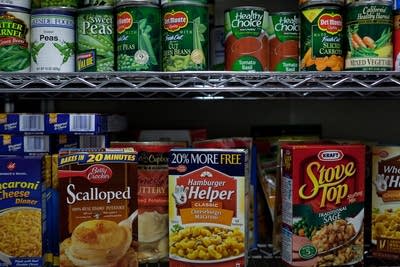Report: 1 in 10 Minn. households lacks access to enough food

The number of Minnesotans who struggle to put food on the table remains at an all-time high. A report from the U.S. Department of Agriculture shows about one in ten Minnesota households lacks access to enough food for a healthy lifestyle.
The report released today is the closest thing to an official "hunger count." Once a year, census workers comb the country to speak with people about food, asking questions like: In the last 12 months, did you or other adults in your household ever not eat for a whole day because there wasn't enough money for food?
They're measuring "food security" — the official term for consistent access to enough food to be healthy.
The report shows 10.2 percent of Minnesota households are food insecure, and 4.3 percent of households are categorized as having "very low food security." In households with very low food security, people sometimes eat less or go without meals due to insufficient funds or other resources for food. The state numbers are based on a three-year average, from 2009 to 2011.
Create a More Connected Minnesota
MPR News is your trusted resource for the news you need. With your support, MPR News brings accessible, courageous journalism and authentic conversation to everyone - free of paywalls and barriers. Your gift makes a difference.
Minnesota is doing better than the country as a whole. Nationally, 14.9 percent of households struggle to put food on the table. Minnesota's numbers have remained steady despite the recession.
"I'm pleased to see that the numbers are fairly stable, but I think it also says we still have work to do," said Erin Sullivan Sutton, assistant commissioner for Children and Family Services at the Minnesota Department of Human Services. "Because any food instability is concerning."
While the percentage of food insecure households in Minnesota is not rising, it appears stuck at record levels. Meanwhile, the number of people seeking help has ballooned in recent years. Many have turned to food stamps, officially called the Supplemental Nutrition Assistance Program.

"We see a growth both in terms of adults in the program, as well as the fastest growth in the last six years has actually been SNAP-eligible children," Sutton said.
In Minnesota, 524,000 people are now on food stamps — more than the combined populations of Minneapolis and Duluth. Meanwhile, Minnesota food shelves now see around three million visits each year.
As Colleen Moriarty sees it, throughout the recession food shelves and increased enrollment in SNAP have helped keep the numbers of hungry people from going even higher. Moriarty is the executive director of Hunger Solutions Minnesota, an advocacy group for food shelves.
"The reason they're not going up more is that we've been more successful in getting people enrolled in the SNAP program," Moriarty said. "I think that we responded as a community really well to the challenges that the food shelves faced when the economy went south. But the question is always, how long can you keep up that pace?"
It's going to be a while before the level of need actually falls, Moriarty says, because the recession has a long tail.
"Even if the economy were to vastly improve today, it takes people 18 to 24 months to get back on their feet," Moriarty said. "You'd still see steady uses of food shelves, if everything just right-sided today. You'd still see it for at least 12 months."
That's the kind of thing that worries Christine Pulver. Pulver runs three food shelves in Ramsey County. As the director of the basic needs program at Keystone Community Services, Pulver is not seeing the rapid growth of a few years ago, but last month she saw another record number of people come for help.

"I think we're looking at the ceiling coming pretty soon for us. We served about 7,600 individuals last month. I think the ceiling is coming when we hit 8,000," Pulver said. "And we simply can't expand beyond that."
Pulver recently reduced the amount of food each person gets, in order to be able to serve everyone. She is seeing signs of improvement; people are finding work. However, their re-employment isn't at the same level as before the downturn.
"They're not getting good jobs. Some jobs are available, but the average hourly wage of jobs we're seeing has dropped," Pulver said. "What we need are more full-time jobs that are paying a livable wage."
That is what it's going to take for many people to be self-sufficient once again and put enough food on the table without help, Pulver said.
